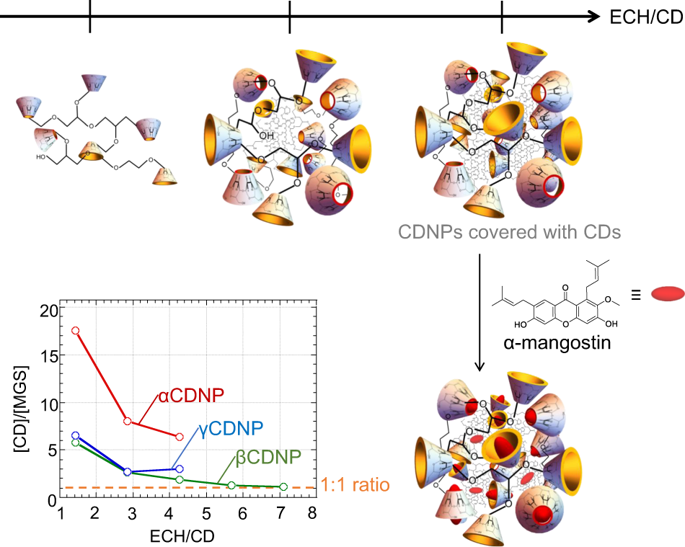Our official English website, www.x-mol.net, welcomes your feedback! (Note: you will need to create a separate account there.)
Cyclodextrin-based nanoparticles encapsulating α-mangostin and their drug release behavior: potential carriers of α-mangostin for cancer therapy
Polymer Journal ( IF 2.8 ) Pub Date : 2019-12-20 , DOI: 10.1038/s41428-019-0296-y Van T. H. Doan , Ji Ha Lee , Rintaro Takahashi , Phuong T. M. Nguyen , Van Anh T. Nguyen , Huong T. T. Pham , Shota Fujii , Kazuo Sakurai
Polymer Journal ( IF 2.8 ) Pub Date : 2019-12-20 , DOI: 10.1038/s41428-019-0296-y Van T. H. Doan , Ji Ha Lee , Rintaro Takahashi , Phuong T. M. Nguyen , Van Anh T. Nguyen , Huong T. T. Pham , Shota Fujii , Kazuo Sakurai

|
α-Mangostin (MGS), an anti-cancer compound, is a xanthone derivative and is extracted from the pericarps of mangosteen. MGS exhibits a variety of bioactivities, such as antioxidant, cytotoxic, anti-inflammatory, and antibacterial effects, as well as anticancer activity. However, MGS has not been approved for clinical use because of its poor bioavailability. There have been many efforts to solve this problem by use of drug carriers. Cyclodextrins (CDs) are well known as nontoxic and biodegradable drug carriers and can encapsulate MGS. In this study, we prepared CD-based nanoparticles (CDNPs) by a polyaddition reaction using epichlorohydrin and characterized them by dynamic light scattering and static light scattering coupled with fractionation. The encapsulation of MGS into CDNPs was examined, and we found that the loading ratio of MGS for CDNPs is much higher than that for CDs themselves. The cytotoxicity of the CDNP/MGS complex was examined, indicating the potential of CDNP as a carrier of MGS. In this study, we synthesized and characterized cyclodextrin-based nanoparticles (CDNPs) by polyaddition reactions using epichlorohydrin and three different type of CDs (α-, β-, and γ-CD). We found that cyclodextrin tended to cover surface of our nanoparticles; while epichlorohydrin network enlarged when weight ratio of epichlorohydrin/cyclodextrin increased. Our CDNPs demonstrated a very high loading ratio against α-mangostin (MGS), and getting close to 1:1 ratio.
中文翻译:

包裹α-芒果苷的环糊精纳米颗粒及其药物释放行为:α-芒果苷用于癌症治疗的潜在载体
α-Mangostin (MGS) 是一种抗癌化合物,是一种呫吨酮衍生物,从山竹果皮中提取。MGS 具有多种生物活性,例如抗氧化、细胞毒性、抗炎和抗菌作用,以及抗癌活性。然而,MGS因其生物利用度差而未被批准用于临床。已经有许多努力通过使用药物载体来解决这个问题。环糊精 (CD) 是众所周知的无毒和可生物降解的药物载体,可以封装 MGS。在这项研究中,我们通过使用表氯醇的加聚反应制备了基于 CD 的纳米粒子 (CDNP),并通过动态光散射和静态光散射与分级分离对其进行了表征。检查了 MGS 在 CDNP 中的封装,我们发现 MGS 对 CDNPs 的加载率远高于 CDs 本身。检查了 CDNP/MGS 复合物的细胞毒性,表明 CDNP 作为 MGS 载体的潜力。在这项研究中,我们通过使用表氯醇和三种不同类型的 CD(α-、β- 和 γ-CD)的加聚反应合成并表征了基于环糊精的纳米粒子 (CDNP)。我们发现环糊精倾向于覆盖我们的纳米颗粒表面;当环氧氯丙烷/环糊精的重量比增加时,环氧氯丙烷网络扩大。我们的 CDNP 对 α-芒果苷 (MGS) 表现出非常高的负载率,接近 1:1 的比例。我们使用表氯醇和三种不同类型的 CD(α-、β- 和 γ-CD)通过加聚反应合成并表征了基于环糊精的纳米粒子 (CDNP)。我们发现环糊精倾向于覆盖我们的纳米颗粒表面;当环氧氯丙烷/环糊精的重量比增加时,环氧氯丙烷网络扩大。我们的 CDNP 对 α-芒果苷 (MGS) 表现出非常高的负载率,接近 1:1 的比例。我们使用表氯醇和三种不同类型的 CD(α-、β- 和 γ-CD)通过加聚反应合成并表征了基于环糊精的纳米粒子 (CDNP)。我们发现环糊精倾向于覆盖我们的纳米颗粒表面;当环氧氯丙烷/环糊精的重量比增加时,环氧氯丙烷网络扩大。我们的 CDNP 对 α-芒果苷 (MGS) 表现出非常高的负载率,接近 1:1 的比例。
更新日期:2019-12-20
中文翻译:

包裹α-芒果苷的环糊精纳米颗粒及其药物释放行为:α-芒果苷用于癌症治疗的潜在载体
α-Mangostin (MGS) 是一种抗癌化合物,是一种呫吨酮衍生物,从山竹果皮中提取。MGS 具有多种生物活性,例如抗氧化、细胞毒性、抗炎和抗菌作用,以及抗癌活性。然而,MGS因其生物利用度差而未被批准用于临床。已经有许多努力通过使用药物载体来解决这个问题。环糊精 (CD) 是众所周知的无毒和可生物降解的药物载体,可以封装 MGS。在这项研究中,我们通过使用表氯醇的加聚反应制备了基于 CD 的纳米粒子 (CDNP),并通过动态光散射和静态光散射与分级分离对其进行了表征。检查了 MGS 在 CDNP 中的封装,我们发现 MGS 对 CDNPs 的加载率远高于 CDs 本身。检查了 CDNP/MGS 复合物的细胞毒性,表明 CDNP 作为 MGS 载体的潜力。在这项研究中,我们通过使用表氯醇和三种不同类型的 CD(α-、β- 和 γ-CD)的加聚反应合成并表征了基于环糊精的纳米粒子 (CDNP)。我们发现环糊精倾向于覆盖我们的纳米颗粒表面;当环氧氯丙烷/环糊精的重量比增加时,环氧氯丙烷网络扩大。我们的 CDNP 对 α-芒果苷 (MGS) 表现出非常高的负载率,接近 1:1 的比例。我们使用表氯醇和三种不同类型的 CD(α-、β- 和 γ-CD)通过加聚反应合成并表征了基于环糊精的纳米粒子 (CDNP)。我们发现环糊精倾向于覆盖我们的纳米颗粒表面;当环氧氯丙烷/环糊精的重量比增加时,环氧氯丙烷网络扩大。我们的 CDNP 对 α-芒果苷 (MGS) 表现出非常高的负载率,接近 1:1 的比例。我们使用表氯醇和三种不同类型的 CD(α-、β- 和 γ-CD)通过加聚反应合成并表征了基于环糊精的纳米粒子 (CDNP)。我们发现环糊精倾向于覆盖我们的纳米颗粒表面;当环氧氯丙烷/环糊精的重量比增加时,环氧氯丙烷网络扩大。我们的 CDNP 对 α-芒果苷 (MGS) 表现出非常高的负载率,接近 1:1 的比例。



























 京公网安备 11010802027423号
京公网安备 11010802027423号